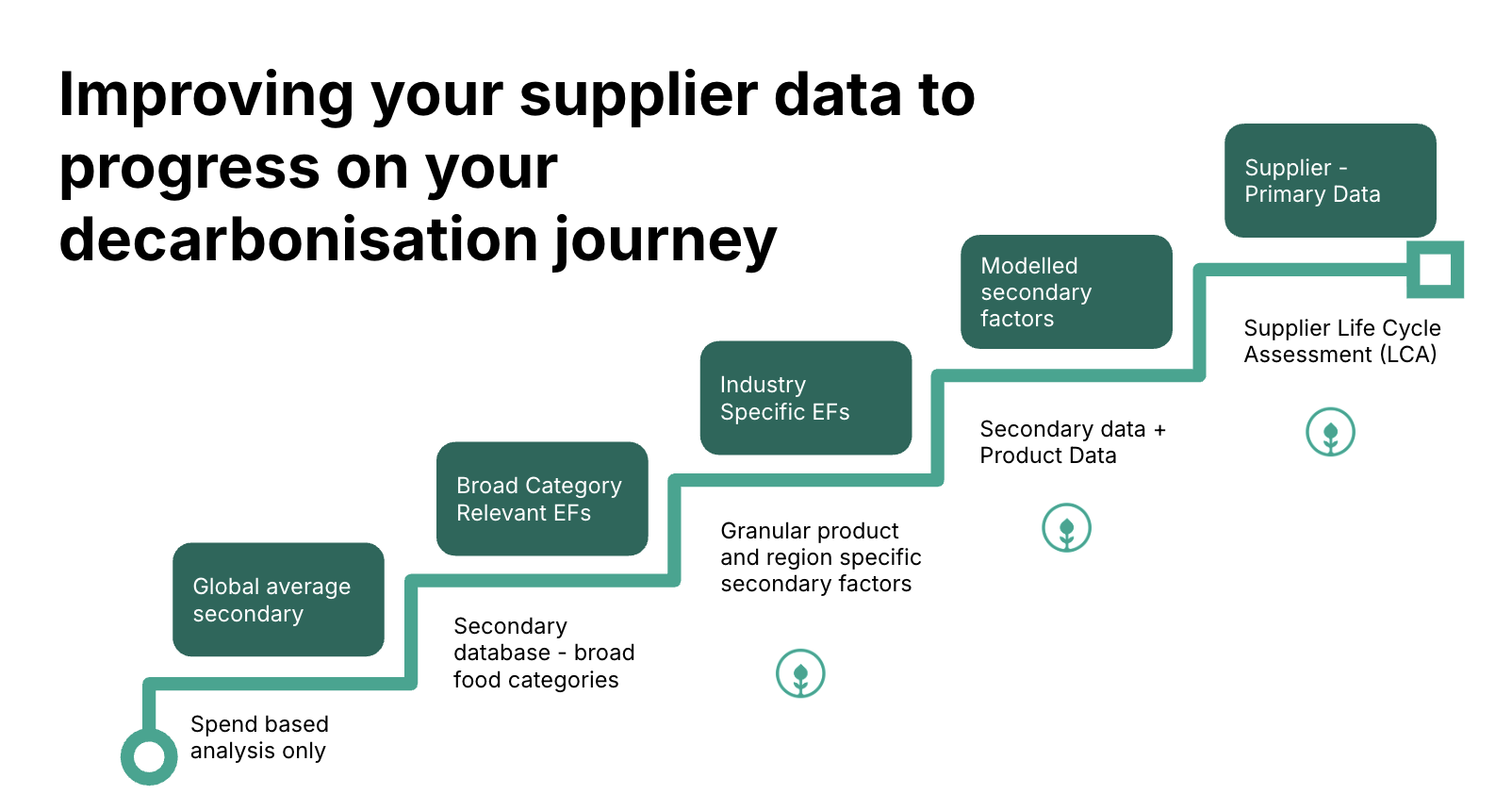Demystifying Supplier Engagement: How to Drive Real Emissions Reductions Through Your Supply Chain
We know the challenge isn't ambition. It's supplier data. Collecting and validating data across hundreds of suppliers—and then finding insights that translate to business priorities—is a challenge most major businesses are facing today. The key? Meeting suppliers where they are today.

This is a recap of our speaking session at Next Generation Ingredients 2025.
Climate change is no longer a distant threat—it's a present business risk that's already impacting supply chains across the food industry. We've seen cocoa production severely disrupted by extreme weather conditions, driving up prices and reducing availability. Coffee prices are climbing as changing climate patterns affect growing regions. The message is clear: climate risk is business risk, and food companies need to act now to mitigate these impacts.
The challenge is that while many businesses focus their decarbonisation efforts on what they can directly control—their Scope 1 and 2 emissions—this approach has fundamental limitations. The reality is that Scope 3 emissions are, on average, 21 times larger than direct emissions. For food businesses, this means that the majority of your environmental impact lies within your supply chain.
The opportunity is significant: companies can unlock 3-6x ROI through supply chain decarbonisation by avoiding future carbon pricing costs.
We know the challenge isn't ambition. It's supplier data. Collecting and validating data across hundreds of suppliers—and then finding insights that translate to business priorities—is a challenge most major businesses are facing today.
Better Data, Better Insights—But It's a Journey
The better your supplier emissions data, the deeper and more useful insights you get into your supply chain—and the more you can trust the decisions you'll make. But suppliers vary vastly in their data maturity. The key is collaboration and meeting them where they are—progressing pragmatically and strategically.
We visualise this as a ladder of progression.

At the bottom rung, you might be working with spend-based analysis or global average secondary data—broad food categories that give you a starting point but limited insight.
As you climb, you progress to more granular, product and region-specific secondary factors, then to modelled secondary factors that incorporate actual product data.
finally, at the top of the ladder, supplier-specific primary data that gives you the most accurate picture of your actual emissions.
The Business Case for Improving Supplier Data
To climb the data maturity ladder, businesses need a repeatable, scalable approach to supplier engagement. Engaging suppliers at scale is the only way to significantly reduce supply chain greenhouse gas emissions.
But it's not just about cutting emissions—it's about gaining visibility, measuring progress, and validating sustainability investments back to the business.
With better supplier-specific data, you can:
- Gain genuine insights into your actual emissions profile, not just industry averages
- Identify concrete opportunities for emissions reduction projects, from ingredient swaps to product innovations to farm-level interventions
- Measure progress over time and demonstrate the value of sustainability investments—especially crucial when sustainable options come at a premium price point
Communicating Clear ROI to Your Suppliers
Many supplier engagement efforts fall short because they treat the process as a one-way data extraction exercise rather than a collaboration. Suppliers need to understand how participation benefits them, not just their customers. There's clear ROI to communicate:
Innovation opportunity
Climate change will affect their products regardless. There are opportunities to decarbonise within their own supply chains, and more customers will be asking for this data. Getting ahead of the curve positions them as forward-thinking partners.
Competitive edge
Showing up as a supplier who is proactive and committed to decarbonisation puts them forward as preferred suppliers. We're seeing more businesses incorporating sustainability criteria into RFPs—it's becoming an expectation, not a nice-to-have.
Business growth
Having verified emissions data builds trust with buyers and increases sales. When we worked with Legghorn, a supplier of lower-carbon, high-welfare chicken mince for the foodservice industry, to independently validate their Lifecycle Assessment (LCA), they doubled sales to a key client within four months.
As Richard Murray, Legghorn's Founder, shared: "Having credible, data-backed sustainability metrics has opened new doors for me… It's strengthened existing relationships with a noticeable uptick in sales."
How Verified Sustainability Data 2X Sales for Legghorn
Real-World Example: Piloting Supplier Engagement with a Leading Food Producer
Here's how this works in practice. We're currently working with a leading producer in convenience foods who faced a common challenge: 46% of their ingredient footprint comes from just 10 suppliers. Despite this concentration, they struggled to validate supplier emissions data with confidence, demonstrate real reductions in Scope 3, and approach the problem in a scalable way.
Through our supplier engagement platform, Supplier Hub, we're running a pilot that's seeing positive interactions with suppliers and genuine willingness to engage. The key to success lies in creating a frictionless experience for suppliers—easy login, straightforward data submission.
For the customer, the platform interprets the sustainability data that suppliers share, eliminating the need for manual analysis. It integrates with Scope 3 reporting, enabling dynamic tracking of progress rather than static annual snapshots. This ultimately transforms supplier engagement from an overwhelming manual task into a manageable, scalable process.
Critical Considerations for Your Strategy
As you develop your supplier engagement strategy, three elements are essential for success.
Understand your footprint and supplier hotspots. Without this baseline, you're navigating in the dark. A comprehensive understanding of where your emissions come from allows you to focus efforts where they'll have the greatest impact.
Develop a clear plan for prioritisation and collaboration. Random outreach won't deliver results—you need a strategic data-driven approach that identifies which suppliers to engage first and how to make collaboration mutually beneficial.
Define your decision-making framework in advance. Data collection for its own sake is a waste of time. Be clear on how you'll use the insights to drive change—whether that's ingredient swaps, supplier selection criteria, or investment in on-farm interventions.
Want to learn more about how Foodsteps can help you engage your suppliers at scale? Get in touch with our team to discuss your specific challenges and opportunities.



